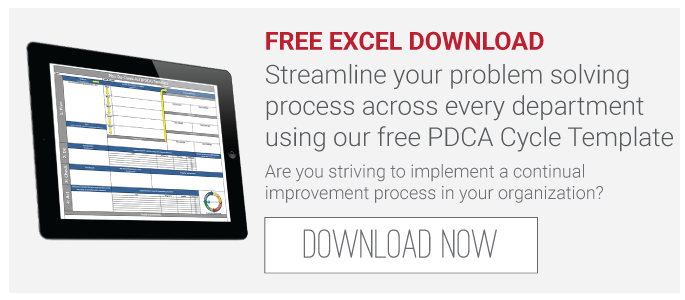Continuous improvement is something all companies (should) strive for but many treat as an abstract concept. To actually achieve a level of continuous improvement, you must have a plan in place – something you can put on paper, execute, evaluate and repeat.
What is the PDCA Cycle?
Step One: Plan
Start by defining the problem and pinpointing the root cause using the 5 Whys, a technique developed in the 1930s by Sakichi Toyoda, founder of Toyota Industries that is still used by Toyota today. You may need to take a more in-depth approach (such as Cause-Effect Diagrams) if the issue is overly complex.
Here is an example of how to use the 5 Whys:
Problem: Your customer received their order two weeks later than you promised.
- Why? Production was delayed in China.
- Why? The factory received the bolts they needed two weeks later than anticipated.
- Why? The bolt supplier did not have the materials ready on time.
- Why? They had trouble sourcing the steel needed to make the bolts.
- Why? Their sourcing manager is new and inexperienced.
Counter-measure: You need to find a secondary bolt supplier that is reliable.
Remember to base everything on hard facts rather than on speculation or assumption. Set SMART goals for your plan. For the above example, your goal could be to qualify a secondary bolt supplier in the Guangdong province of China within 30 days.
Get started now! Download your FREE PDCA CYCLE EXCEL TEMPLATE here.
Step Two: Do
Now that you have defined your problem and found the root cause, it is time to brainstorm potential solutions. Once you have your options laid out, determine which you believe will be most practical. Test it out on a small scale (do not fully implement). Think of the “do” phase as the “test” phase.
Example: Continuing the scenario above, you need to find a bolt supplier in Guangdong, China in the next 30 days. Your office is located in the US. You have identified three options: 1) Find a supplier online, 2) Send your sourcing manager to China to find a supplier or 3) Hire a sourcing agent in China to find a supplier on your behalf. You must weigh the costs and risks of each option.
- What is your budget?
- Which option will allow you to successfully qualify a new supplier in 30 days?
- What are your criteria for qualifying the new supplier?
- Who will draw up a contract?
Step Three: Check
This step may also be referred to as the “study” phase (as in the Deming Cycle). Assess the outcome of the pilot solution. If you realize there is room for improvement, make necessary changes and repeat the “do” and “check” phases until you feel you have reached a comprehensive solution.
Example: You decided to hire a sourcing agent in China to locate and qualify a secondary bolt supplier on your behalf. You need to determine if this was the best option.
- Did the sourcing agent accomplish the task to your specifications?
- Are you satisfied with the amount of money and time spent?
- Did anything go wrong? What obstacles had to be overcome?
- What factors could you change to improve the process?
- Should you have sent your own sourcing manager instead? Would it have been worth the cost?
Perform an analysis to answer these questions.
Step Four: Act
The final step is to fully implement your solution. If you are solving an isolated issue, congratulations! You are finished. If you are striving for continuous improvement, you should repeat the cycle from Step One: Plan to find additional opportunities for improvement. Lather, rinse, repeat.
Example: Based on your analysis, you have determined that if you need to quickly qualify a secondary supplier in the future, it could be worthwhile to send your sourcing manager to China instead of hiring a local agent. Head back to Step One of the Cycle to re-map your new plan and use the knowledge you gained from your pilot test to make improvements. When the situation arises again, implement your new plan following the Cycle in its entirety. If that becomes your new standard process for qualifying suppliers in a pinch, work continuously to identify areas of weakness and room for improvement to perfect the process.
4 Benefits of Using PDCA
- Provides a standardized method to achieving continuous improvement that can be used by employees in any department to resolve new and recurring issues
- Prevents wasted time implementing ineffective or inferior solutions
- Fosters teamwork through brainstorming and problem-solving
- Inexpensive – Overcome obstacles internally
3 Tips for Successfully Implementing PDCA
- Upper management must be on-board and treat the Cycle as a mandatory policy for change
- Remember this is a circular plan, not a one-way plan
- Implement in all departments of organization
Additional Resources
Check out these resources for more on continuous improvement:





.jpg?width=176&height=56&name=MR_associatedNetwork_logo%20(1).jpg)